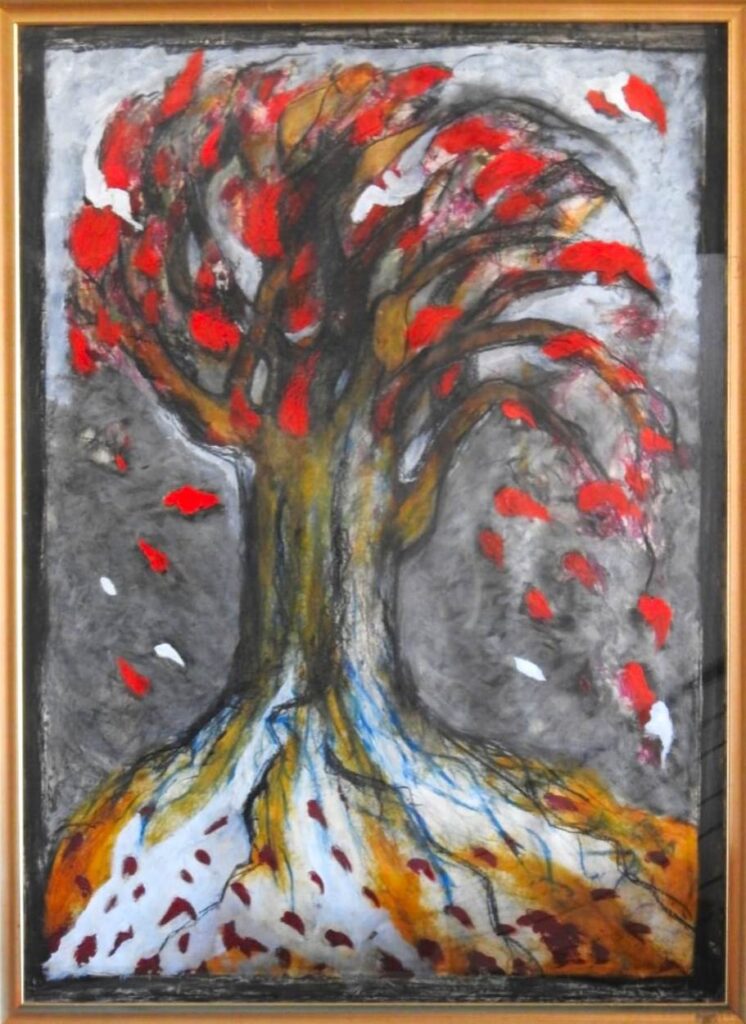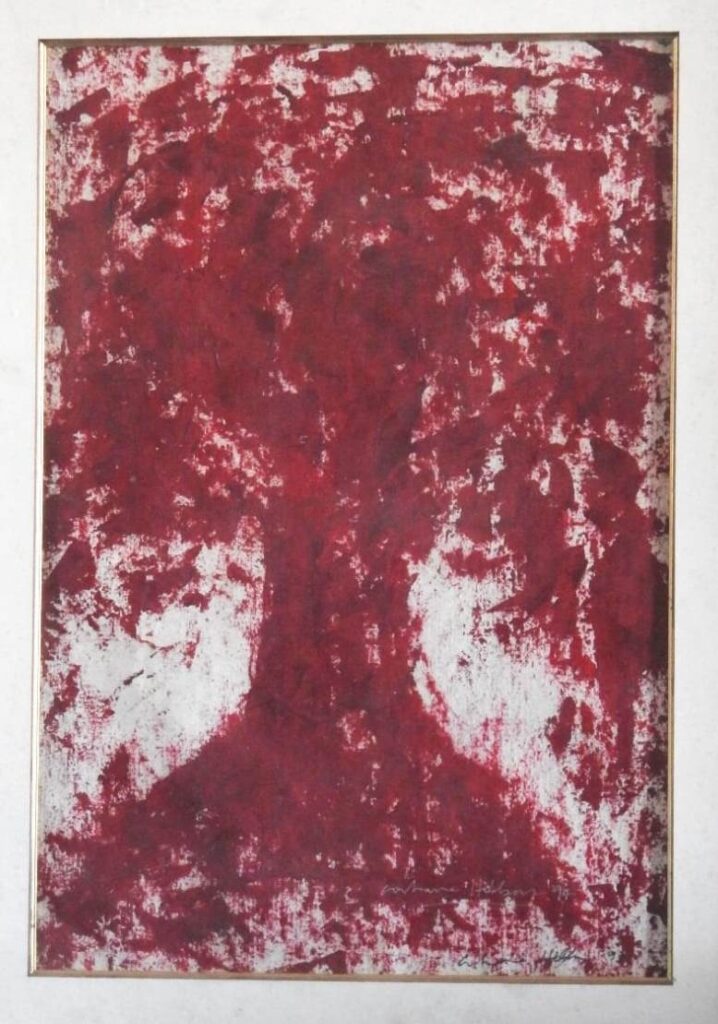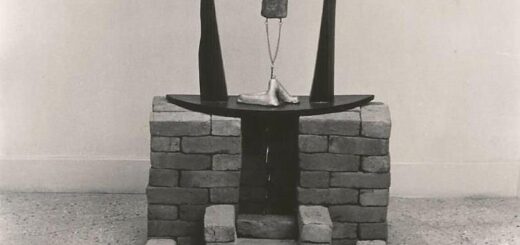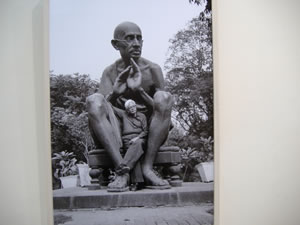Autumn Tree of Pleasure – Japan/Archana Hebbar Colquhoun
- The Tree has a Symbolism that is Timeless and Universal in its Origins. The Expressions are limitless and found in all cultures and religions.
The Bhagawad Gita (15.1)
Lord Krishna describes the divine Ashvattha tree, as that whose roots grow upwards and the branches of which extend downwards; its leaves are the sacred knowledge of the Vedas; the knower of this tree has attained the knowledge of the Vedas.
Carl Gustav Jung
“No tree, it is said, can grow to heaven unless its roots reach down to hell.”
The above two quotes, to me, point to the limitless ways in which the symbolism of a tree can be expressed.
I would like to place my painting “Autumn Tree of Pleasure” within the context of the extensive symbolism that the Tree has generated in our imagination.
In this essay, I would like to talk about the visual devices I used in the painting of the autumn tree to depict time, movement, and the part that memory plays in the creation of an artwork. I painted the ‘autumn tree’ before I moved back to India, at the turn of the century.
- Materials used in the painting
The autumn tree is painted on an imperial size card sheet with charcoal, pastels, acrylic paints, and a bit of turmeric for the yellow – or is the yellow pigment not turmeric?
The quality and range of paper types, including the sizes and formats of cut and rolled paper that I encountered in Japan filled me with such joy and amazement that I switched from sculpture and installation art to painting, for a time.
- The Tree and the Painting

In the painting, I wanted to show – most of all – the movement of falling leaves.
Fall is another name for autumn.
A tree shedding its autumnal leaves, the shade of kumkum red – deep, rich, dense, and tactile – is an annual spectacle of nature that is witnessed only in some parts of the world, which have a temperate climate.
- My relationship with the tree
Coming from the tropics i.e. southern India, I found the concept of the four seasons not just novel but in some respects alien.
After the first few years of living in Japan, I began to form my own, personal relationship with each of the four seasons that came and went in a regular cycle, without exception, every year.
Summer is perhaps the least favourite season for most people in Japan and it was the same for me.
Of the other three seasons – the soft, gentle spring, preceded by a cold, crisp, snowy winter, and the third the autumn with the grandeur of its colours and dazzling hues – is my most inspirational.
- Picking a singular iconic image of a tree and blotting out the surrounding panoramic stretch
The subject of the painting, The Autumn Tree of Pleasure, which I painted after having lived through several Japanese autumns, harked back to an image (of a painting of an autumn tree) that was already present in my mind as a vivid and abiding memory, for more than a decade, before I visited Japan and made the country my second home.
I am referring here to the well-known Indian miniature painting titled “Squirrels in a Chinar Tree” by the master painter Abu’l-Hasan (see NOTE below) who worked in the Mughal emperor, Jahangir’s atelier in the seventeenth century. The Chinar tree grows in the valleys of Kashmir and is considered to be a symbol of Kashmir’s rich, cultural and environmental heritage.
I was introduced to this painting in my art history classes in Baroda. The shape of the leaves of the Chinar tree, the flame-red hue of many of them (alongside the green leaves) depicted in the Mughal miniature painting, I found puzzling and fascinating. This was a tree in the early stages of an autumnal metamorphosis. Such a tree, where leaves seemed to take the place of flowers because of their distinctive colours, I had never seen in southern India.
[NOTE: The work is sometimes attributed to the artist Mansur or considered to be a collaborative work by the two artists. In any case, works of art not only in India but also in Europe were the result of collective work by trainee artists and artisans who worked under the auspices of a single master to whom then the work of art would be attributed. The painting is in the collection of a museum outside India as are a large number of other masterpieces of Indian art. A simple Internet search will disclose all necessary information on the painting. Due to copyright restrictions I have not included an image of the painting, which is titled in most cases “Squirrels in a Plane Tree.”]
- The Chinar tree and my painting
The Chinar tree belongs to the family of Plane trees and resembles the Japanese maple tree. It is considered to be an endangered species going by the rapidly decreasing numbers of the tree in Kashmir. One of the features of the Chinar tree is its deep and extensive root growth that covers a ground area larger than the spread of its tree top. The bifurcation of the tree trunk into roots is visible just above the ground level where the tree rises in its magnificence.
The roots of a Chinar tree need to breathe and be able to draw nutrients and generous amounts of water from the surrounding soil for its survival, healthy growth, and longevity. When road construction and building works are carried out close to and right above the ground area where the roots of the Chinar tree lie the death of the tree from suffocation and starvation soon follows.
- A Pictorial Analysis of the painting “An Autumn Tree of Pleasure” through Q & A
Q1. What sort of a tree is the Autumn Tree of Pleasure, is it a Chinar tree?
A1. The tree in the painting is a generic, deciduous tree that sheds its leaves in the autumn but before it starts to bare its branches, a performance takes place whereby the green leaves turn into a golden yellow followed by a deep orange, and/or finally a blood-red hue.
Q2. How did this painting come about?
A2. I can best answer the question in the form of a sequence diagram using words and symbols as follows:
a memory + a life experience → a memory retrieval through synchronic activation within the brain ↔ a motivation to create = the final art work
Note: It is a mystery as to why only certain memories and or life experiences lead to the production of an artwork, especially when the artwork is purely self-motivated and is not a work that is commissioned by a patron.
Q3. How is movement depicted in the painting? What pictorial devices do you employ to show movement in a static, two-dimensional representation of an image?
A3. The following four elements are used to depict movement in the painting.
- Wind
- Shifting axis in the composition
- Suggestion of Time through placement of pictorial elements on the picture surface
- Change in pigmentation
1. Wind creates movement which in turn disturbs the leaves, dislodging them from the branches, and speeds up the process of the falling of the leaves.
2. Diagonal lines in a composition can also be used to show movement. In the painting the branches of the tree are drawn in sweeping, rightward curves the arcs pointing downwards.
3. Time represents movement. The passing of time is inferred from the position of the leaves painted as individual elements in a random pattern at varying levels within the painting, which shows the descent of the leaves to the ground at different times.
4. Change in pigment can also indicate the passing of time. The leaves on the ground are painted dark red the colour of dried blood and it can be understood that the leaves have been on the ground for some time, in contrast to the brighter red of the leaves that are shown airborne.
The painting, Autumn Tree of Pleasure, to me represents the tragic history of Kashmir. The region was considered a paradise on earth, depicted as such in countless paintings and in the romantic song sequences of Indian movies till just a few decades ago.
As a visual artist, I have so far rarely repeated an artistic idea or a form, unless I am in the process of exploring the various facets and permutational possibilities of the idea. Use of different materials comes into play when I want to express an idea through different media – paintings, sculptures, art installations etc.

A variation on the autumn tree is a painting which I made using only the red viscous liquid that comes in a tiny tube with a dipper for painting a bindi – a red dot or an elongated line on the forehead, which is commonly used in India by women as a chief element of facial makeup.
I sometimes refer to the painting as A Red Tree, which I painted very soon after painting The Autumn Tree of Pleasure.
Photo Credit: Arun Visweswaran












What struck me looking at the tree was that it encapsulated ‘time’ and ‘change’. The painting shows of process of the leaves changing color and then each taking its time to drop once the tree cannot hold them due to the vagaries of nature. In this sense the different colors you have used can immediately be related to ‘change’ and the movement of the leaves to ‘time’.
The other point you have raised in the write-up is about which memory does an artist draw upon to craft an art work. Well, here I think memory is continually interacting with experience. So your sojourn in Japan unconsciously was linked to your memory of what you were close to in India, growing up and studying. This raises a fundamental question for artist and writer, namely, how much of memory and how much of experience do we draw upon to make ourselves visible?
I really liked your final statement about how our memories are linked to our identity, and not only that, that part of our identity that we choose to project or present to the world. This is an extrapolation of the point you made i.e. “..how much of memory and how much of experience do we draw upon to make ourselves visible?”
What an astute comment and there’s so much depth and a number of possibilities for learning in just that one observation you made.
It’s made me realize that perhaps my life in the U.K. in recent years is a life not of present day U.K. that I am living but a life that I have already lived elsewhere – in India and Japan.
Archana
What a beautiful depiction of autumn/fall colors. Very true to the real bright reds that we see in Canada and the shedding of the leaves is nicely shown. It’s like I could visualise the shedding, the darker shades of color of the leaves on the floor is also so true to nature. With the use of minimal colors , and nice strokes of the brush I could truly experience the falling of leaves and the wind along with it. The white at the root of the tree reminds me of the early snow we get in Canada , transitioning to winter from fall. Beautiful painting. A picture or painting speaks a thousand words they say and it is true here.
Thank you Maya for your comment.
I’m glad you were able to read the painting as intended. Of course, an artwork can have endless meanings but if a primary meaning of the work is perceived by a viewer it is always a matter of satisfaction for the artist.
Still, you found other readings in the work.
One interesting point you made was the use of white at the roots of the tree making it appear as if winter is in a hurry to take over from autumn, even before autumn has completed its process of transitioning.
This makes me wonder if I used the white more as a colourist device or if I was making a conscious or even unconscious reference to snow and the coming of winter through the use of white.
The red coloured tree reminded me of the bright red may flowers which bloom all over Bangalore and nearby places during Summer. There are only red flowers on the trees but no leaves. It truly is a treat for the eyes. A good write up with a lot of interesting info.
Mangala, thank you for your response.
It was the very same experience that you describe, which drew me to the Japanese maple tree in its autumn state with their leaves turning from green to red as though mimicking the bright red blossoms of the Ashoka trees that lined the beautiful avenues of Bangalore, which sadly have become a rare sight over the last decade or so.
What was left unsaid in my write up, which is the correlation between the familiar and the unfamiliar (another aspect of my painting), was brought to light through your straightforward reference to the red tree blossoms of a Bangalore summer.
Painting speak itself powerful expression of the artist through the beautiful colour of the great nature. Very impressive, spontaneous, rhythmic line which I feel very personally a poetry of nature.
Your writing about your own painting, it’s just overlap the truth of your beautiful painting. I feel it’s better than your sculpture, here your vision is very clear.
Maybe I poor in writing but like it very much. THANKS.
Thank you for the comment Madan Lal.
It’s always good to read what you have to say about my work as you have seen some of my work and these two paintings in particular.
I’ll talk about my sculptures at some point and would be interested to know what your response would be.
Any writing on an artwork is essentially an overlap, whether or not the writing is by the artist about their own work or it is a critique formulated by another.
However, I find that an art work starts to speak in a tongue of its own once it finds itself in the public domain.
Very interesting write-up. We have just gone through a season where the jacaranda was in full bloom in Bangalore, and it was a sight to behold. Liked the movement of the falling leaves !
Thanks Arun for the comment and making the connection with the Jacaranda tree. The photograph you took is much appreciated.